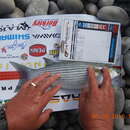Migration
provided by Fishbase
Oceanodromous. Migrating within oceans typically between spawning and different feeding areas, as tunas do. Migrations should be cyclical and predictable and cover more than 100 km.
- Recorder
- Crispina B. Binohlan
Morphology
provided by Fishbase
Dorsal spines (total): 5; Dorsal soft rays (total): 8; Analspines: 3; Analsoft rays: 9
- Recorder
- Cristina V. Garilao
Trophic Strategy
provided by Fishbase
Occur mainly in estuaries, congregating over mud-banks (Ref. 2830). Presence of large tricuspid teeth, with sharp cutting edges essential to dislodge and reduce attached diatoms, filamentous algae and pieces of macro-plant detritus in size prior to ingestion (Ref. 74863).
- Recorder
- Grace Tolentino Pablico
Biology
provided by Fishbase
Occur mainly in estuaries, congregating over mud-banks (Ref. 2830). Oviparous, eggs are pelagic and non-adhesive (Ref. 205). Omnivore (Ref. 97629). Fleshy highly esteemed (Ref. 4393).
- Recorder
- Crispina B. Binohlan
Importance
provided by Fishbase
fisheries: minor commercial; gamefish: yes; price category: medium; price reliability: very questionable: based on ex-vessel price for species in this family
- Recorder
- Crispina B. Binohlan
Chelon tricuspidens
provided by wikipedia EN
Chelon tricuspidens, the striped mullet, is a species of ray-finned fish from the family Mugilidae. It is found in southern Africa where its known range comprises Mossel Bay and the Kosi Estuary in South Africa. Its habitatis muddy areas in estuaries.[1] This species and the Diassanga mullet (Chelon bandialensis) are closely related and these two taxa seem to have separated when the Benguela Current, as it exists today, was formed about 3-12 million years ago.[2]
References
-
^ Froese, Rainer; Pauly, Daniel (eds.) (2018). "Chelon trucspidens" in FishBase. June 2018 version.
-
^ Jean-Dominique Durand & Alan K. Whitfield (2015). "Biogeography and Distribution of Mugilidae in the Western, Central and Southern Regions of Africa". In Donatella Crosetti & Stephen J. M. Blaber (eds.). Biology, Ecology and Culture of Grey Mullets (Mugilidae). CRC Press. p. 112. ISBN 1482252139.

- license
- cc-by-sa-3.0
- copyright
- Wikipedia authors and editors
Chelon tricuspidens: Brief Summary
provided by wikipedia EN
Chelon tricuspidens, the striped mullet, is a species of ray-finned fish from the family Mugilidae. It is found in southern Africa where its known range comprises Mossel Bay and the Kosi Estuary in South Africa. Its habitatis muddy areas in estuaries. This species and the Diassanga mullet (Chelon bandialensis) are closely related and these two taxa seem to have separated when the Benguela Current, as it exists today, was formed about 3-12 million years ago.
- license
- cc-by-sa-3.0
- copyright
- Wikipedia authors and editors

